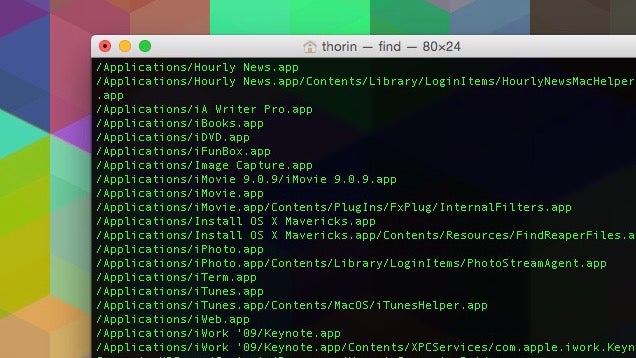

- MAC TERMINAL COMMANDS OPEN FILE CODE
- MAC TERMINAL COMMANDS OPEN FILE SERIES
- MAC TERMINAL COMMANDS OPEN FILE MAC
Terminal is located in the Applications > Utilities folder.
MAC TERMINAL COMMANDS OPEN FILE MAC
Terminal isn’t for the faint of heart and we’d rather you be comfortable entering some of these commands.Īlso, why not try out some of the Mac apps available on Envato Market, such as Sentenza Desktop for Mac, which makes it very simple to build applications for Mac OS X.
MAC TERMINAL COMMANDS OPEN FILE SERIES
Tip: If you’re unfamiliar with Terminal, I would strongly encourage you to read our introductory series on the topic, Taming the Terminal. Saying that, the Terminal is a fickle creature and leaves no margin for error so make sure you’re entering the commands exactly as they are written here.Īs always, make sure you have a recent backup in case something does happen. To demonstrate just how versatile the Terminal is, I’ve rounded up 40 truly excellent Terminal tips and tricks that can come in very handy.Īll of the Terminal commands I’ll be showing you are perfectly safe to use and, when it comes to changing preferences, are completely reversible. There’s a great deal that Terminal can do, from moving large numbers of files to changing preferences that we didn’t even know exist. It’s a topic we’ve covered at length before with our popular series Taming the Terminal. The Terminal is an exceptionally powerful tool, providing a command line interface to the underpinnings of OS X. Start up your Terminal again and type in the new alias you just created. If your terminal is open or still running, quit it in order to refresh it. Once you’ve created the alias and set it equal to a command, save the changes you’ve made to the file and close it. This is the primary command in the alias command that makes opening up desired applications via the Terminal super convenient. Open is a great starter for opening up applications and/or documents you use regularly.

Important!! Make sure that not only your syntax is correct, but that your directory path is correct! If not, the alias will not be able to successfully jump to your desired location and perform that task. There can’t be any spaces in between the quotation marks and the commands in the string expression, and no spaces in between the equal sign and the alias name.

In this instance, the name of the file I want to open is “py-notes.txt” and the absolute file path is /Documents/pythonpractice/py-notes.txt Be Careful Here’s what I type into my ~/.bash_profile:Īlias pynotes="open ~/Documents/pythonpractice/py-notes.txt" You must know the exact filename and file path of the file you want to open! I’ll set this new alias, pynotes, to the command that automatically opens my Python notes. To access my Python notes, I’d like to call it pynotes. Decide on the alias command you want to create.
MAC TERMINAL COMMANDS OPEN FILE CODE
It’s done all in one!įor example, I’m going to make an alias that will allow me to quickly open a note taking file I use for learning more Python (By the way, they’re just an example of lines of Python code in those notes.).

The ~ (tilde, pronounced ‘TIL-dah’) sign is handy because it’ll take you directly to the location of the file without you having to return to the root directory level with separate commands. This command opens the file, regardless of where you may be in any of your directory levels. The alias edit means that when you type the command in that word and press Enter in the Terminal, it will follow the command that it equates to, which would be open ~/.bash_profile. Regardless, let’s get to making our own!Īt the bottom, copy this into the file: # Aliases # Establishing custom commands below alias edit="open ~/.bash_profile"īelow the commenting is where you find the standard syntax for creating an alias (shortcut command) for your machine to recognize. There’s also a possibility that there may not be any. Once you’re in the file, you may find some aliases that have already been established. You could also just open that file with the command open ~/.bash_profile. Type nano ~/.bash_profile if you prefer using the nano GNU in order to make critical changes to the file. bash_profile, for instance, to open and write into in order to create customized shortcut commands for your daily usage. Once your in the Terminal, type ls -a to be given a list of files and folders that are both hidden and not hidden. You can simply command+ SPACE to bring up the search bar. Make sure you’re going to create these customized commands in the right file. bash_profile might really be where all the magic happens for creating shortcut commands in the Terminal! If you’re sort of familiar with the general Unix command line commands that allow you to navigate through your machine via the Terminal, then creating aliases will help optimize your navigation process! It’s pretty easy, too.


 0 kommentar(er)
0 kommentar(er)
